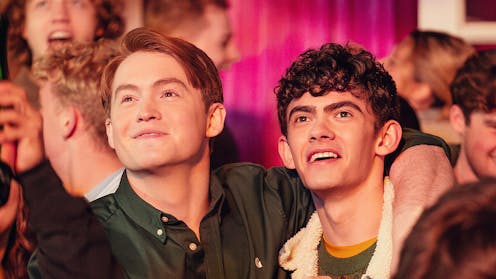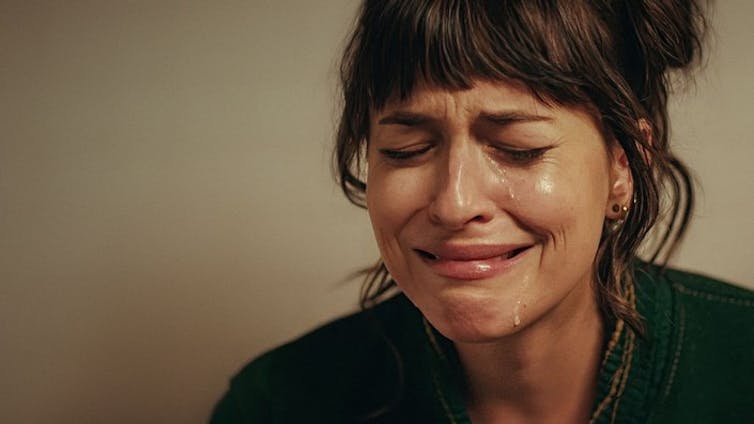
Imagine suddenly longing for a past you’ve only seen in a show filmed before you were born. Or, reverse that: Imagine wishing you could re-do your childhood while watching a brand new show like Heartstopper, set in the present day.
Heartstopper is a Netflix hit series, jam-packed with queer and trans teens finding love, accented by cute cartoon leaves fluttering across the screen.
Sounds adorable? Yes, but if you came out later in life, grew up in an unsupportive environment or never had a teen romance, the anemoia you feel may be intense.
If you’ve yet to hear the word anemoia, forgive yourself. Anemoia was only recently defined by The Dictionary of Obscure Sorrows as “nostalgia for a time you never experienced.” The growing obsession with what’s known as Y2K core — fashion, music and culture inspired by the 90s and early 2000s — by Gen Z is an example of this kind of intergenerational envy.
Unlike other forms of nostalgia, neuroscientist Felipe De Brigard tells us that anemoia “doesn’t need real memories.” De Brigard explores the darker side of these complex feelings. He says propaganda can misinform people about the past to elicit a longing for a time that may never have existed.
According to De Brigard, given the right material, we can create simulations of possible scenarios in our minds. We might imagine a different present or an alternative past.
Imagining what could have been
While watching Heartstopper‘s love story unfold in our living rooms, we feel happy for the fictional characters, but anger, grief and a dash of betrayal can creep in as well.
For many Heartstopper viewers, the series blends into memories from our real life. Watching queer and trans teens portrayed as ordinary people can feel like a breath of fresh air, especially if these scenes are inconsistent with our own adolescence. According to media studies professor Frederik Dhaenens, Heartstopper also uses cute esthetics that amplify these positive depictions while “soften[ing] the blow of negative experiences” faced by the characters.

Memories from our past start to flood through our minds as we watch. We may find ourselves wishing for the queer childhood we never had. If only I was born later, we might think. Viewers may imagine how their lives could have unfolded differently, if only they had better media representation or were surrounded by more liberal perspectives.
Enter queer anemoia: nostalgia for a do-over of an earlier stage of your life in a different time or place. While commonly expressed by queer and trans folks over 40, anyone who harbours some grief over their coming-out process or the lack of acceptance they had growing up may find themselves riding this emotional rollercoaster.
A moment of recognition
Queer anemoia is a moment of recognition. It is the contrast between our imagined teen love and — for many, but of course not all — the real past — lonely and isolated.
The sight of a thriving trans teen like Heartstopper’s Elle could elicit strong feelings for a viewer who transitioned later in life and missed their own girlhood.
Maybe the word trans wasn’t even accessible to help them make sense of their identity.
Thinking about the past is not unusual for queer and trans folks. With some sarcasm, you could call it a hobby. Hey, want to hang out tonight and subject our adolescence and coming-out stories “to the judgment of hindsight?” Media push this exercise further by helping us visualize what could have been.
'I Kissed a Girl’
Another show described similarly to Heartstopper is the reality TV show I Kissed A Girl. The Guardian described it as “a celebratory, joyful love letter to queerness” and “the sweetest, most touching” show.

Among a surplus of straight couples in reality TV, I Kissed A Girl is one of only a handful of shows with queer cast members. But perhaps this is shifting. Sociologist Róisín Ryan-Flood and queer historian Amy Tooth Murphy argue that we are undergoing “one of the most dramatic transformations of gender and sexuality in social life in recent decades.”
By portraying lesbians as ordinary people with ordinary desires, I Kissed A Girl contributes to this transformation. Some viewers’ might find their own ideas about what is possible, desirable and even aspirational beginning to change.
Media can model these possibilities for us, which contributes to our identity formation. Feminist and queer theorists agree, arguing that our gender and sexual identities are collectively created, not self-made.
For example, gender studies professor Amira Lundy-Harris explains how when we encounter others in media — novels, film, television — they can help us recognize something about ourselves.
Therefore these mediated identities — these characters on TV — are not just ours. We co-create our identities with a variety of different forms of media, including social media and memoirs. We also do this with other people, including our families and friends. The cultural and political moment we are living in is also part of this collaborative identity-making process.
Late bloomers may feel more anemoia
Queer anemoia is a politically useful feeling. When we compare different cultural moments we may also recognize that we did not learn about our identity in isolation from the rest of the world. Feminist philosopher Sue Campbell has said our feelings require others to help us interpret and make sense of them. Through their characters and stories, media offer us an interpretive context for our feelings to emerge.
Some late bloomers — especially those left feeling confused or surprised by their sexual or gender identities — may blame themselves for going along with a mainstream, heteronormative or cisnormative cultural script without stopping to ask themselves who they really are. It may be hard, at first, to see that our identities are co-created.
A recently released film, Am I Ok? portrays a late bloomer, Lucy, who is 32 when she finally realizes she’s a lesbian. She’s frustrated and disappointed in herself as she tells her best friend, “I should have figured this out by now.”
Unfortunately, the film does not explore other reasons for her predicament — like compulsory heterosexuality — that are no fault of her own.

Naming the ‘nostalgia’
British education professor Catherine Lee, who previously taught secondary school under the homophobic Section 28, wrote in The Conversation about how she was filled with regret as she watched the queer teachers in Heartstopper give their students the supportive environment she never could.
Even Heartstopper director Andy Newbery felt queer anemoia before working on the third season. He said:
“I’ve heard it many, many times since, especially from people sort of my age really, about how they wish they’d had a show like this when they were growing up.”
Naming queer anemoia gives us language for these complex, bittersweet feelings. In today’s political climate, cute portrayals of queer and trans love may not continue to grace our screens, but taking our feelings seriously and asking what they tell us about the role of media in our lives must never stop.
Rena Bivens does not work for, consult, own shares in or receive funding from any company or organisation that would benefit from this article, and has disclosed no relevant affiliations beyond their academic appointment.
This article was originally published on The Conversation. Read the original article.







